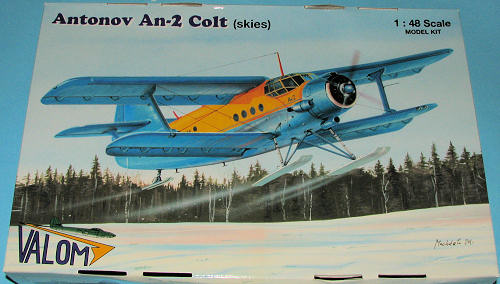
Valom 1/48 An-2 'Colt' (skis)
| KIT #: | 48005 |
| PRICE: | $ |
| DECALS: | Two options |
| REVIEWER: | Scott Van Aken |
| NOTES: | Injected plastic with photo etch and resin parts |

| HISTORY |
The An-2 is used as a light utility transport, parachute drop aircraft, agricultural work and many other tasks suited to this large slow-flying biplane. Its slow flight and good field performance make it suited for short, unimproved fields, and some specialized variants have also been built for cold weather and other extreme environments. The Guinness Book of World Records states that the 45-year production run for the An-2 was for a time the longest ever, for any aircraft, but it was recently exceeded by the Lockheed C-130 Hercules.
The Antonov An-2 was designed to meet a 1947 Soviet requirement for a replacement for the Polikarpov Po-2 which was used in large numbers as both an agricultural aircraft and a utility aircraft. Antonov designed a large single bay biplane of all-metal construction, with an enclosed cockpit and a cabin with room for seats accommodating twelve passengers. The first prototype, designated SKh-1, and powered by a Shvetsov ASh-21 radial engine, flew on 31 August 1947. The second prototype was fitted with a more powerful Shvetsov ASh-62 engine, which allowed the aircraft's payload to be significantly increased from 1,300 kg (2,870 lb) to 2,140 kg (4,720 lb), and in this form it was ordered into production.
By 1960 the USSR had produced over 5,000 units. Since 1960, most An-2s have been built at Poland's WSK factory in Mielec, with over 13,000 made there before full production ended in 1991. Limited production from parts stocks, as well as spares and maintenance coverage continued until 2001, when 4 aircraft were produced for Vietnam. China also builds the An-2 under license as the Shijiazhuang Y-5.
The An-2 was designed as a utility aircraft for use in forestry and agriculture. However, the basic airframe is highly adaptable and numerous variants have been developed. These include hopper-equipped versions for crop-dusting, scientific versions for atmospheric sampling, water-bombers for fighting forest-fires, flying ambulances, float-equipped seaplane versions, lightly armed combat versions for dropping paratroops, and of course the most common An-2T version, which is the 12-seater passenger aircraft. All versions (other than the An-3) are powered by a 750 kW (1,000 hp) nine-cylinder Shvetsov ASh-62 radial engine, which was developed from the Wright R-1820.
The An-2 has design features which make it suitable for operation in remote areas with unsurfaced airstrips:
A note from the pilot's handbook reads: "If the engine quits in instrument conditions (blind flying when you can't see the ground) or at night, the pilot should pull the control column full aft (it won't stall) and keep the wings level. The leading-edge slats will snap out at about 64 km/h (40 mph), and when the airplane slows to a forward speed of about 40 km/h (25 mph), the airplane will sink at about a parachute descent rate until the aircraft hits the ground."
The An-2 indeed has no stall speed quoted in the operating handbook. Pilots of the An-2 say one can fly the aircraft in full control at 30 mph (as a contrast, a modern Cessna four-seater light aircraft has a stall speed of around 55 mph). This slow stall speed makes it possible for the aircraft to fly backwards (if the aircraft is pointed into a headwind of, say, 35 mph (56 km/h), it will travel backwards at 5 mph (8.0 km/h) whilst under full control). (This is also possible with almost any other true Short Take Off and Landing (STOL) aircraft, but the Antonov has the distinction of being able to do the trick in the mildest headwind).
| THE KIT |
 Backing up a bit, this is Valom's initial boxing, which came with the 'bad' clear bit mentioned in the earlier article. This situation has now been corrected and all current boxings have the proper part. The kit is very nicely molded in the usual grey plastic that one expects from Valom.
Backing up a bit, this is Valom's initial boxing, which came with the 'bad' clear bit mentioned in the earlier article. This situation has now been corrected and all current boxings have the proper part. The kit is very nicely molded in the usual grey plastic that one expects from Valom.
The kit is very nicely molded in the usual grey plastic that one expects from Valom. There are four large grey sprues and one clear sprue that contains the canopy aforementioned. A small photo etch fret is included as are resin parts. In fact, the main difference between the various boxings are the bits that come in resin. As you can see from the sprues image, you get multiples of some parts, such as prop blades, so Valom provides the plastic bits for all boxings in every boxing.
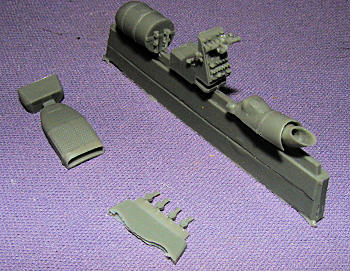
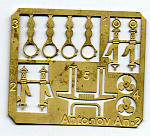 As mentioned, the parts have very nice engraved molding. There is a full cockpit with the belts and some small bits in photo etch as well as a resin center console. There is also sidewall detail with radios and a few other instruments molded in place. The main instrument panel is nicely done though the instrument faces themselves are without detail. This makes it easy to install instrument decals if you have one of the various sets that are on the market. The aft cockpit bulkhead has quite a bit of detail on it as well. In the cabin are two rows of jump seats along each of the fuselage walls.
As mentioned, the parts have very nice engraved molding. There is a full cockpit with the belts and some small bits in photo etch as well as a resin center console. There is also sidewall detail with radios and a few other instruments molded in place. The main instrument panel is nicely done though the instrument faces themselves are without detail. This makes it easy to install instrument decals if you have one of the various sets that are on the market. The aft cockpit bulkhead has quite a bit of detail on it as well. In the cabin are two rows of jump seats along each of the fuselage walls.
The kit provided a reasonable engine face and a variety of prop blades. The kit will tell you which to use. The blades are butt fit on a hub with resin counterweights. 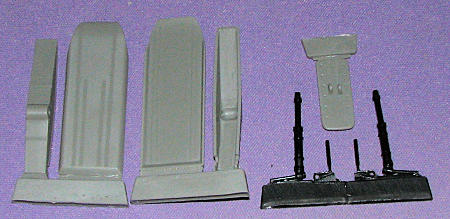 Building the wings will be one of the more complex portions of the kit as there are a lot of aileron/flap hinges and one needs to properly remove the wings from the plastic mounts to get the correct straight wing positioning. However, the instructions are quite detailed in this regard so patience and methodical construction should carry one through OK. Since this kit is for a ski equipped aircraft, it is natural that there would be skis included. These and the new main gear are s
Building the wings will be one of the more complex portions of the kit as there are a lot of aileron/flap hinges and one needs to properly remove the wings from the plastic mounts to get the correct straight wing positioning. However, the instructions are quite detailed in this regard so patience and methodical construction should carry one through OK. Since this kit is for a ski equipped aircraft, it is natural that there would be skis included. These and the new main gear are s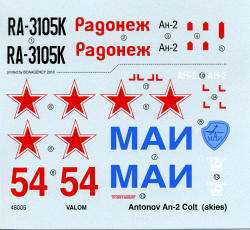 uperbly molded and appear to be quite strong. There is the requirement to do a bit of drilling and to make some additional braces from stretched sprue, but once one gets to the level of building these sorts of kits, that skill is already learned and exercised.
uperbly molded and appear to be quite strong. There is the requirement to do a bit of drilling and to make some additional braces from stretched sprue, but once one gets to the level of building these sorts of kits, that skill is already learned and exercised.
Instructions are the typical Valom book with a variety of paint references. The construction steps are well drawn with a number of additional insert drawings to help through some of the more complex build processes. Markings in this kit are for two aircraft. First is the box art plane in a very fetching blue and yellow scheme from VIHREVO in 2009. The other is a standard Russian military plane from the Moscow Aviation Institue from 2010 in a standard OD over light blue. The decals are very nicely done and look to be nice and thin.
| CONCLUSIONS |
I know many who have been waiting for this kit in 1/48. It won't be a simple build and so I'd recommend it for more advanced modelers. One thing for sure, it isn't going to be a small model so leave some room on the shelf for this one.
| REFERENCES |
http://en.wikipedia.org/wiki/An-2
November 2010 My thanks to Valom for sending in the preview kit. If you would like your product reviewed fairly and fairly quickly, please contact the editor or see other details in the Note to Contributors.